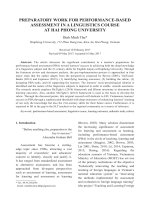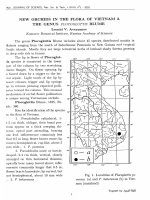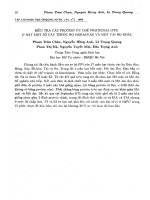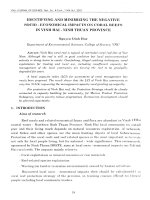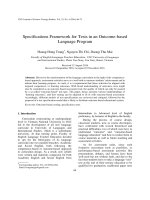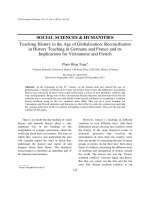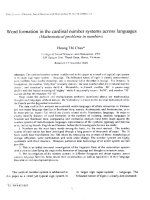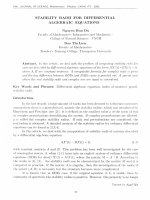DSpace at VNU: L-p estimates for the (partial derivative)over-bar-equation on a class of infinite type domains
Bạn đang xem bản rút gọn của tài liệu. Xem và tải ngay bản đầy đủ của tài liệu tại đây (241.73 KB, 15 trang )
2nd Reading
November 14, 2014 15:14 WSPC/S0129-167X
133-IJM
1450106
International Journal of Mathematics
Vol. 25, No. 11 (2014) 1450106 (15 pages)
c World Scientific Publishing Company
DOI: 10.1142/S0129167X14501067
¯
Lp estimates for the ∂-equation
on a class
of infinite type domains
Int. J. Math. 2014.25. Downloaded from www.worldscientific.com
by CORNELL UNIVERSITY on 12/17/14. For personal use only.
Ly Kim Ha
Department of Mathematics and Computer Science
University of Science, Vietnam National University
227 Nguyen Van Cu Q.5
Ho Chi Minh City, Vietnam
Tran Vu Khanh
Tan Tao University, Tan Tao Avenue
Tan Duc e-City, Long An Province, Vietnam
Department of Mathematics
National University of Singapore
Blk S17, 10 Lower Kent Ridge Road
Singapore 119076, Singapore
Andrew Raich
Department of Mathematical Sciences
SCEN 327, 1 University of Arkansas
Fayetteville, AR 72701, USA
Received 1 October 2013
Accepted 21 October 2014
Published 18 November 2014
We prove Lp estimates, 1 ≤ p ≤ ∞, for solutions to the Cauchy–Riemann equations
¯ = φ on a class of infinite type domains in C2 . The domains under consideration are a
∂u
¯
class of convex ellipsoids, and we show that if φ is a ∂-closed
(0, 1)-form with coefficients
¯ = φ, then u p ≤ C φ p where the
in Lp and u is the Henkin kernel solution to ∂u
constant C is independent of φ. In particular, we prove L1 estimates and obtain Lp
estimates by interpolation.
¯ Henkin solution; Henkin operator; Lp estimates for ∂;
¯ infinite type
Keywords: ∂;
domains.
Mathematics Subject Classification 2010: 32W05, 32F32, 32T25, 32T99
1450106-1
2nd Reading
November 14, 2014 15:14 WSPC/S0129-167X
133-IJM
1450106
L. K. Ha, T. V. Khanh & A. Raich
1. Introduction
A fundamental question in several complex variables is to establish Lp estimates
for solutions of the Cauchy–Riemann equation
Int. J. Math. 2014.25. Downloaded from www.worldscientific.com
by CORNELL UNIVERSITY on 12/17/14. For personal use only.
¯ =φ
∂u
on domains Ω ⊂ Cn . In this paper, we provide the first examples of infinite type
domains for which Lp bounds hold, 1 ≤ p ≤ ∞. The domains under consideration
¯
(0, 1)-form
are a class of convex ellipsoids in C2 , and we show that if φ is a ∂-closed
¯ = φ, then u p ≤ C φ p where the constant C
and u is the Henkin solution to ∂u
is independent of φ. Specifically, we prove L1 estimates and use the Riesz–Thorin
Interpolation Theorem to obtain Lp estimates by interpolating with the L∞ estimates established by Khanh [12]. The L∞ estimates of Khanh generalized and were
inspired by the L∞ estimates of Fornæss et al. [9].
We investigate domains of the following form: Ω ⊂ C2 is a smooth, bounded
domain with a global defining function ρ such that: for any p ∈ bΩ, there exist a
coordinates zp = Tp (z) with the origin at p where Tp is a linear transformation,
and functions Fp , and rp such that
Ωp = Tp (Ω) = {zp = (zp,1 , zp,2 ) ∈ C2 : ρ(Tp−1 (zp )) = Fp (|zp,1 |2 ) + rp (zp ) < 0}
(1.1)
or
Ωp = Tp (Ω) = {zp = (zp,1 , zp,2 ) ∈ C2 : ρ(z) = Fp (x2p,1 ) + rp (zp ) < 0}
where zp,j = xp,j + iyp,j , xp,j , yp,j ∈ R, j = 1, 2, and i =
the functions Fp : R → R and rp : C2 → R satisfy:
(1)
(2)
(3)
(4)
(1.2)
√
−1. We also assume that
Fp (0) = 0;
F (t)
Fp (t), Fp (t), Fp (t), and ( pt ) are non-negative on (0, dp );
∂rp
rp (0) = 0 and ∂zp,2
= 0 on bΩ with |z1,p | ≤ δ;
rp is convex,
where dp is the square of the diameter of Ωp and δ is a small number. We will also
require that each Fp satisfies a certain log integrability property.
This class of domains includes two well-known examples. If Ω is of finite type
2m, then Fp (t) = tm at the points of type 2m. On the other hand, if Fp (t) =
exp(−1/tα ), then Ω is of infinite type at p, and this is our main case of interest. We
call our domains Ω ellipsoids because they are generalizations of real and complex
ellipsoids in C2 . Classically, a complex ellipsoid in Cn is a domain of the form
{z = (z1 , . . . , zn ) ∈ Cn : nj=1 |zj |2mj < 1}, and a real ellipsoid is a domain of
n
2nj
+ y 2mj ) < 1} where
the form {z = (x1 + iy1 , . . . , xn + iyn ) ∈ Cn :
j=1 (x
mj , nj ∈ N, 1 ≤ j ≤ n. Our hypotheses include the following two classes of infinite
1450106-2
2nd Reading
November 14, 2014 15:14 WSPC/S0129-167X
133-IJM
1450106
¯
Lp estimates for the ∂-equation
on a class of infinite type domains
type domains:
1
exp −
Ω = z = (z1 , z2 ) ∈ C2 :
|zj |αj
j=1
and
2
2
1
exp −
Ω = z = (x1 + iy1 , x2 + iy2 ) ∈ C2 :
α
|x
j| j
j=1
≤ e−1 ;
1
+ exp −
|yj |βj
≤ e−1 ,
where αj , βj ∈ (0, 1). Moreover, our setting also includes domain
Int. J. Math. 2014.25. Downloaded from www.worldscientific.com
by CORNELL UNIVERSITY on 12/17/14. For personal use only.
Ω=
z = (x1 + iy1 , x2 + iy2 ) ∈ C2 : exp 1 −
1
|x1 |α
+ χ(y1 ) + |z2 |2 ≤ 1
where χ is a convex function and χ(y1 ) = 0 when |y1 | < δ and 0 < α < 1. This is a
tube domain of infinite type at 0. This domain provides an interesting example for
studying necessary and sufficient conditions for local regularity of ∂¯ on domains of
infinite type. In fact, the canonical solution of ∂¯ associated to this tube domain has
superlogarithmic estimate and is locally regular if and only if α < 1 (see [1, 6, 14]).
¯
dating back
There is a long history of proving Lp estimates for the ∂-equation,
to the work of Kerzman [11] and Øvrelid [16]. In [15], Krantz proved essentially
optimal Lipschitz and Lp estimates on strongly pseudoconvex domains. In the case
that Ω is a real ellipsoid, Diederich et al. obtained sharp H¨
older estimates [7] while
Chen et al. established optimal Lp estimates for complex ellipsoids [4]. See also
Range [17] and Bruna and del Castillo [2]. Both real and complex ellipsoids are
domains of finite type, and the analysis in the referenced works depends in an
essential fashion on the type. In C2 , Chang et al. [3] proved Lp estimates for the
¯
∂-Neumann
operator on weakly pseudoconvex domains of finite type. See [4, 9] and
the references within for a more complete history.
More recently, there has been work on supnorm estimates for the Cauchy–
Riemann equations on infinite type domains in C2 . Fornæss et al. provided the
first examples in [9] and Khanh found that the estimates hold when domains are
of the type (1.1) or (1.2) [12]. In particular, Khanh proved the following.
Theorem 1.1 ([12, Theorem 1.2]). If there exists δ > 0 so that
(1) Ω is defined by (1.1) and
(2) Ω is defined by (1.2) and
δ
0
δ
0
|log Fp (t2 )| dt < ∞ for all p ∈ bΩ, or
|log (t) log Fp (t2 )| dt < ∞ for all p ∈ bΩ,
¯
then for any bounded, ∂-closed
(0, 1)-form φ on Ω, the Henkin solution u on Ω
¯
satisfies ∂u = φ and
u
L∞(Ω)
≤C φ
where C > 0 is independent of φ.
1450106-3
L∞ (Ω) ,
2nd Reading
November 14, 2014 15:14 WSPC/S0129-167X
133-IJM
1450106
L. K. Ha, T. V. Khanh & A. Raich
In this paper, we will prove the Lp -version of Theorem 1.1. Our technique yields
Lp -estimates both in the finite and infinite type cases.
Theorem 1.2. If there exists δ > 0 and either of the following conditions hold :
(1) Ω is defined by (1.1) and
(2) Ω is defined by (1.2) and
δ
0
δ
0
|log Fp (t2 )| dt < ∞ for all p ∈ bΩ,
|log(t) log Fp (t2 )| dt < ∞ for all p ∈ bΩ,
¯
then for any ∂-closed
(0, 1)-form φ in Lp (Ω) with 1 ≤ p ≤ ∞, the Henkin kernel
¯ = φ and
solution u on Ω satisfies ∂u
u
Lp (Ω)
≤C φ
Lp (Ω) ,
Int. J. Math. 2014.25. Downloaded from www.worldscientific.com
by CORNELL UNIVERSITY on 12/17/14. For personal use only.
where C > 0 is independent of φ.
The following examples show that the Lp estimates in Theorem 1.2 are sharp
in the case of infinite type case.
Example 1.1. For 0 < α < 1, let Ω be defined by
Ω = {(z1 , z2 ) ∈ C2 : e
1− |z 1|α
1
+ |z2 |2 < 1}.
Then for any φ ∈ Lp (Ω) with 1 ≤ p ≤ ∞, there is a solution u of the equation
¯ = φ such that u ∈ Lp (Ω). Moreover, if p = ∞, there is no solution u ∈ Lq (Ω)
∂u
with q > p.
The organization of the paper is as follows: we recall the construction of the
Henkin solution via the Henkin kernel in Sec. 2. We prove Theorem 1.2 in Sec. 3
and discuss Example 1.1 in Sec. 4.
2. Henkin Solution
In this section, we recall the construction of the Henkin kernel and Henkin solution
¯ For complete details, see [10, 18], or for a more modern treatment, see [5].
to ∂.
Our construction follows the lines of Khanh [12] and Range [Chap. V, Sec. 1, 18]
to build a Leray map that focuses on the local behavior of the kernel.
Definition 2.1. A C2 -valued C 1 function G(ζ, z) = (g1 (ζ, z), g2 (ζ, z)) is called a
Leray map for Ω if g1 (ζ, z)(ζ1 − z1 ) + g2 (ζ, z)(ζ2 − z2 ) = 0 for every (ζ, z) ∈ bΩ × Ω.
¯ so that
A support function Φ(ζ, z) for Ω is a smooth function defined near bΩ × Ω
Φ admits a decomposition
2
Φj (ζ, z)(ζj − zj ),
Φ(ζ, z) = 2
j=1
¯ holomorphic in z, and vanish only on the
where Φj (ζ, z) are smooth near bΩ × Ω,
diagonal {ζ = z}.
1450106-4
2nd Reading
November 14, 2014 15:14 WSPC/S0129-167X
133-IJM
1450106
¯
Lp estimates for the ∂-equation
on a class of infinite type domains
∂ρ ∂ρ
For a convex domain, it is well known that G(ζ, z) = ∂ρ
∂ζ = ( ∂ζ1 , ∂ζ2 ) is a Leray
map [5, Lemma 11.2.6], and Φ defined by the Leray map
∂ρ(ζ)
,
∂ζj
Φj (ζ, z) =
j = 1, 2,
is a support function for Ω.
2
¯
¯ The solution
zj be a bounded, C 1 , ∂-closed
(0, 1)-form on Ω.
Let φ = j=1 φj d¯
¯
¯
u of the ∂-equation, ∂u = φ, provided by the Henkin kernel is given by
u = T φ(z) = Hφ(z) + Kφ(z).
(2.1)
Int. J. Math. 2014.25. Downloaded from www.worldscientific.com
by CORNELL UNIVERSITY on 12/17/14. For personal use only.
where
1
Hφ(z) =
2π 2
1
Kφ(z) =
4π 2
∂ρ(ζ) ¯
∂ζ1 (ζ2
ζ∈bΩ
Ω
∂ρ(ζ) ¯
∂ζ2 (ζ1
Φ(ζ, z)|ζ − z|2
− z¯2 ) −
− z¯1 )
φ(ζ) ∧ ω(ζ),
(2.2)
φ1 (ζ)(ζ¯1 − z¯1 ) − φ2 (ζ)(ζ¯2 − z¯2 ) ¯
ω(ζ) ∧ ω(ζ),
|ζ − z|4
where ω(ζ) = dζ1 ∧ dζ2 . See, for example, [9, 7]. To understand the Lp -norm of u,
it suffices to investigate the Lp mapping properties of integral operators H and K.
As a consequence of the Riesz–Thorin Interpolation Theorem and Theorem 1.1,
proving that T is a bounded, linear operator on L1 (Ω) suffices to establish that T
is a bounded linear operator on Lp (Ω), 1 ≤ p ≤ ∞.
The L1 -estimate of |Kφ(z)| is standard and does not require interpolation.
Indeed, since |ζ − z|−3 ∈ L1 (Ω) in both ζ and z (separately), Lp boundedness
of K, 1 ≤ p ≤ ∞, follows from [8, Theorem 6.18].
The expression for H given in (2.2) uses the fact that φ is defined on bΩ.
However, after an integration by parts (done below), H has an expression that is
an integral over Ω. Once we show that H is bounded on L10,1 (Ω), then the density
1
¯ ∩ ker ∂¯ in L1 (Ω) ∩ ker ∂¯ finishes the argument (the density argument
(Ω)
of C0,1
0,1
follows by using the argument of [5, Lemma 4.3.2], keeping in mind that a convex
domain is star-shaped and we can ignore the technicalities associated with ∂¯∗ ).
Alternatively, Krantz [15, p.257] presents an argument which also discusses how to
pass from estimates on smooth forms on the boundary to merely Lp forms in Ω.
For the boundedness of H, we first begin the analysis of Hφ(z) by using Stokes’
¯
Theorem. Using the assumption that φ is ∂-closed,
we observe
Hφ(z) =
1
2π 2
Φ1 (ζ, z)(ζ¯2 − z¯2 ) − Φ2 (ζ, z)(ζ¯1 − z¯1 )
ψ(ρ(ζ)) ∧ φ(ζ) ∧ ω(ζ),
∂¯ζ
(Φ(ζ, z) − ρ(ζ))(|ζ − z|2 + ρ(ζ)ρ(z))
Ω
where ψ ∈ C ∞ (R) is a cutoff function so that 0 ≤ ψ ≤ 1 and
ψ(t) =
1
for t ≥ −δ/8,
0
for t ≤ −δ/4.
1450106-5
2nd Reading
November 14, 2014 15:14 WSPC/S0129-167X
133-IJM
1450106
L. K. Ha, T. V. Khanh & A. Raich
We abuse notation slightly and let H(ζ, z) be the integral kernel of H. As a consequence of Tonelli’s Theorem, it suffices to prove that
|H(ζ, z)φ(ζ)|dV (ζ, z)
φ
L1 (Ω)
< ∞.
(2.3)
(ζ,z)∈Ω×Ω
Since H(ζ, z) = 0 when ρ(ζ) ≤ −δ/4, it suffices to prove
|H(ζ, z)φ(ζ)| dV (ζ, z)
(ζ,z)∈{ζ∈Ω:ρ(ζ)>−δ/4}×Ω
φ
L1 (Ω) .
Int. J. Math. 2014.25. Downloaded from www.worldscientific.com
by CORNELL UNIVERSITY on 12/17/14. For personal use only.
Direct calculation shows that
Φ1 (ζ, z)(ζ¯2 − z¯2 ) − Φ2 (ζ, z)(ζ¯1 − z¯1 )
ψ(ρ(ζ))
(Φ(ζ, z) − ρ(ζ))(|ζ − z|2 + ρ(ζ)ρ(z))
|H(ζ, z)| ≤ ∂¯ζ
1
|Φ(ζ, z) − ρ(ζ)|2 (|ζ − z|2 + ρ(ζ)ρ(z))1/2
+
1
,
|Φ(ζ, z) − ρ(ζ)|(|ζ − z|2 + ρ(ζ)ρ(z))
(2.4)
recognizing that
|ζ − z|
|ζ − z|
≤
(|ζ − z|2 + ρ(ζ)ρ(z))
|ζ − z|(|ζ − z|2 + ρ(ζ)ρ(z))1/2
=
(|ζ −
z|2
1
.
+ ρ(ζ)ρ(z))1/2
Since ρ is smooth, ρ is Lipschitz, so (ρ(ζ) − ρ(z))2
|ζ − z|2 . Therefore, ρ(ζ)2
|ζ − z|2 + ρ(ζ)ρ(z), hence |ζ − z| + |ρ(ζ)| (|ζ − z|2 + ρ(ζ)ρ(z))1/2 . Thus
|Φ(ζ, z) − ρ(ζ)|
|ζ − z| + |ρ(ζ)|
(|ζ − z|2 + ρ(ζ)ρ(z))1/2 .
(2.5)
Combining (2.4) and (2.5), we obtain
1
|Φ(ζ, z) − ρ(ζ)|2 (|ζ − z|2 + ρ(ζ)ρ(z))1/2
|H(ζ, z)|
≤
1
.
|Φ(ζ, z) − ρ(ζ)|2 |ζ − z|
(2.6)
Since bΩ is compact, there exists δ > 0 and points p1 , . . . , pN ∈ bΩ so that
bΩ is covered by{B(pj , δ)}N
j=1 . After changing coordinates to set pj to 0 with the
1450106-6
2nd Reading
November 14, 2014 15:14 WSPC/S0129-167X
133-IJM
1450106
¯
Lp estimates for the ∂-equation
on a class of infinite type domains
transformation Tpj in Sec. 1, we may assume the goal is to prove
(ζ,z)∈(Ωpj ∩B(0,δ))×Ωpj
(·))
φ(Tp−1
j
|H(Tp−1
(ζpj ), Tp−1
(zpj ))φ(Tp−1
(ζpj ))| dV (ζpj , zpj )
j
j
j
L1 (Ωpj )
≈ φ
L1 (Ω) ,
(2.7)
where
Ωpj = {ρpj (zpj ) := ρ(Tp−1
(zpj )) = Ppj (zpj ,1 ) + rpj (zpj ) < 0}
j
Int. J. Math. 2014.25. Downloaded from www.worldscientific.com
by CORNELL UNIVERSITY on 12/17/14. For personal use only.
and Ppj (zpj ,1 ) = Fpj (|zpj ,1 |2 ) or P (zpj ,1 ) = F (x2pj ,1 ) as in Sec. 1. Since
Φ(Tp−1
(ζpj ), Tp−1
(zpj )) = Φpj (ζpj , zpj ),
j
j
where, Φpj is the support function of Ωpj , we obtain
|H(Tp−1
(ζpj ), Tp−1
(zpj ))|
j
j
1
.
|Φpj (ζpj , zpj ) − ρpj (ζpj )|2 |ζpj − zpj |
(2.8)
Here and in what follows, we omit the subscript pj and still use φ(·) for φ(Tp−1
(·)).
j
3. Proof of Theorem 1.2
We will investigate the complex and real ellipsoid cases separately to show (2.7).
First, however, we recall the following facts for the class of real functions F in
the first part with the additional assumption that F (0) = 0. See, for example,
[9, Lemma 4].
Lemma 3.1. Let F be a C 2 convex function on [0, d]. Then
F (p) − F (q) − F (q)(p − q) ≥ 0
for any p, q ∈ [0, d]. If, in addition, F (0) = 0 and F
(3.1)
is nondecreasing, then
F (p) − F (q) − F (q)(p − q) ≥ F (p − q),
(3.2)
for any 0 ≤ q ≤ p ≤ d.
Proof. The proof of (3.1) is simple and is omitted here. For (3.2), let s := p−q ≥ 0
and g(s) := F (s+ q)− F (q)− sF (q)− F (s). Hence, g (s) = F (s+ q)− F (q)− F (s)
and g (s) = F (s + q) − F (s). Using the assumption F (t) is nondecreasing, we
have g (s) ≥ 0, thus g (s) is nondecreasing. This implies g (s) ≥ g (0) = 0 (since
F (0) = 0) and consequently that g(s) is increasing. We thus obtain g(s) ≥ g(0) = 0
(since F (0) = 0). This completes the proof of (3.2).
1450106-7
2nd Reading
November 14, 2014 15:14 WSPC/S0129-167X
133-IJM
1450106
L. K. Ha, T. V. Khanh & A. Raich
3.1. Complex ellipsoid case
In this subsection, Ω is defined by (1.1). Since the argument of F is |ζ1 |2 , the
chain rule shows that ∂ζ∂ 1 F (|ζ1 |2 ) = ζ¯1 F (|ζ1 |2 ). Similarly to Khanh [12, (4.1)], the
convexity of r shows that
Re{Φ(ζ, z)} − ρ(ζ) ≥ −ρ(z) + F (|z1 |2 ) − F (|ζ1 |2 ) − 2F (|ζ1 |2 )Re{ζ¯1 (z1 − ζ1 )}
= −ρ(z) + F (|ζ1 |2 )|z1 − ζ1 |2 + (F (|z1 |2 ) − F (|ζ1 |2 )
− F (|ζ1 |2 )(|z1 |2 − |ζ1 |2 )).
(3.3)
Int. J. Math. 2014.25. Downloaded from www.worldscientific.com
by CORNELL UNIVERSITY on 12/17/14. For personal use only.
The analysis splits into two cases: (i) F (0) = 0 and (ii) F (0) = 0. In the first case,
the hypotheses on F guarantee the existence of a δ > 0 such that F (|ζ1 |2 ) > 0 for
any |ζ1 | < δ. Hence,
Re{Φ(ζ, z)} − ρ(ζ)
−ρ(z) + |z1 − ζ1 |2
and
|H(ζ, z)| ≤
1
.
(|ρ(z)|2 + |ImΦ(ζ, z)|2 + |ζ1 − z1 |4 )|ζ1 − z1 |
The estimate in this case is the estimate for the case of a strongly pseudoconvex
domain, and the result is classical and well-known. Thus, we may assume that
F (0) = 0.
Lemma 3.2. Let F be defined as in Sec. 1 with the additional assumption F (0) =
0. Then, for any |z1 |, |ζ1 | ≤ d
1
(|ρ(z) + iImΦ(ζ, z)|2 + F 2 (|z1 − ζ1 |2 ))|z1 − ζ1 | if |ζ1 | ≥ |z1 − ζ1 |,
|H(ζ, z)|
1
if |ζ1 | ≤ |z1 − ζ1 |.
(|ρ(z) + iImΦ(ζ, z)|2 + F 2 ( 12 |z1 |2 ))|z1 |
(3.4)
Proof. Applying Lemma 3.1 to (3.3), we obtain
F (|ζ1 |2 )|z1 − ζ1 |2
Re{Φ(ζ, z)} − ρ(ζ) ≥ −ρ(z) +
F (|z1 |2 − |ζ1 |2 )
if 0 < |z1 |, |ζ1 | < d,
if |ζ1 | ≤ |z1 | ≤ d.
(3.5)
We now compare the relative sizes of |ζ1 | and |z1 − ζ1 |.
Case 1. |ζ1 | ≥ |z1 − ζ1 |. Combining the first inequality from (3.5) with (ii) from
p. 2, we obtain
Re{Φ(ζ, z)} − ρ(ζ) ≥ −ρ(z) + F (|z1 − ζ1 |2 ).
The first line of (3.4) follows by this inequality and (2.6).
1450106-8
2nd Reading
November 14, 2014 15:14 WSPC/S0129-167X
133-IJM
1450106
¯
Lp estimates for the ∂-equation
on a class of infinite type domains
Case 2. |ζ1 | ≤ |z1 − ζ1 |. In this case, the estimate depends on the relative sizes of
|ζ1 | and √12 |z1 |. If |ζ1 | ≥ √12 |z1 |, then the argument from Case 1 proves that
Re{Φ(ζ, z)} − ρ(ζ) ≥ −ρ(z) + F (|z1 − ζ1 |2 )|z1 − ζ1 |2 ≥ −ρ(z) + F
1
|z1 |2 ,
2
and we obtain the second estimate in (3.4). Otherwise, |ζ1 | ≤ √12 |z1 |, and this
implies both |z1 | ≥ |ζ1 | and |z1 − ζ1 | ≥ (1 − √12 )|z1 |. By the second case of (3.5),
we observe that
1
|z1 |2
2
Re{Φ(ζ, z)} − ρ(ζ) ≥ −ρ(z) + F (|z1 |2 − |ζ1 |2 ) ≥ −ρ(z) + F
Int. J. Math. 2014.25. Downloaded from www.worldscientific.com
by CORNELL UNIVERSITY on 12/17/14. For personal use only.
and
(|Re{Φ(ζ, z)} − ρ(ζ)|2 + |ImΦ(ζ, z)|2 )|ζ1 − z1 |
|ρ(z) + iImΦ(ζ, z)|2 + F 2
1
|z1 |2
2
|z1 |.
(3.6)
This completes the proof.
Proof of Theorem 1.2(1). From (2.7), the only remaining estimate is the integral
over (ζ, z) ∈ (Ω∩B(0, δ))×Ω. We now concentrate on the integral near 0. By Lemma
3.2, we have
|H(ζ, z)φ(ζ)| dV (ζ, z)
(ζ,z)∈(Ω∩B(0,δ))×Ω
=
(ζ,z)∈(Ω∩B(0,δ))×Ω and |ζ1 |≥|z1 −ζ1 |
···
+
(ζ,z)∈(Ω∩B(0,δ))×Ω,|ζ1 |≤|z1 −ζ1 | and |z1 |≤2δ
+
(ζ,z)∈(Ω∩B(0,δ))×Ω,|ζ1 |≤|z1 −ζ1 | and |z1 |≥2δ
···
···
(I) + (II) + (III),
(3.7)
where
(ζ,z)∈(B(0,2δ)∩Ω)2
|φ(ζ)|dV (ζ, z)
,
(|ρ(z) + iImΦ(ζ, z)|2 + F 2 (|z1 − ζ1 |2 ))|z1 − ζ1 |
(ζ,z)∈(B(0,2δ)∩Ω)2
|φ(ζ)|dV (ζ, z)
,
(|ρ(z) + iImΦ(ζ, z)|2 + F 2 ( 12 |z1 |2 ))|z1 |
(I) :=
(II) :=
(III) :=
(ζ,z)∈(B(0,δ)∩Ω)×Ω and |z1 |≥2δ
|φ(ζ)|dV (ζ, z)
.
(|ρ(z) + iImΦ(ζ, z)|2 + F 2 ( 12 |z1 |2 ))|z1 |
(3.8)
1450106-9
2nd Reading
November 14, 2014 15:14 WSPC/S0129-167X
133-IJM
1450106
Int. J. Math. 2014.25. Downloaded from www.worldscientific.com
by CORNELL UNIVERSITY on 12/17/14. For personal use only.
L. K. Ha, T. V. Khanh & A. Raich
It is easy to see that (III) (F (2δ 2 )δ)−1 φ L1 (Ω) . For the integral (I), we make the
change of variables (α, w) = (α1 , α2 , w1 , w2 ) = (ζ1 , ζ2 , z1 − ζ1 , ρ(z) + iImΦ(ζ, z)).
The Jacobian of this transformation is the matrix
1
0
0
0
0
0
1
0
0
0
0
0
1
0
0
0
0
0
1
0
J = −1
0
0
0
1
0
−1
0
0
0
∂ρ(z)
0
0
0
0
∂(Rez1 )
∂ImΦ(ζ,z)
∂(Reζ1 )
∂ImΦ(ζ,z)
∂(Imζ1 )
∂ImΦ(ζ,z)
∂(Reζ2 )
∂ImΦ(ζ,z)
∂(Imζ2 )
∂ImΦ(ζ,z)
∂(Rez1 )
0
0
0
0
0
0
0
0
0
0
0
0
0
0
0
1
0
0
∂ρ(z)
∂(Imz1 )
∂ρ(z)
∂(Rez2 )
∂ρ(z)
∂(Imz2 )
∂ImΦ(ζ,z)
∂(Imz1 )
∂ImΦ(ζ,z)
∂(Rez2 )
∂ImΦ(ζ,z)
∂(Imz2 )
To justify this coordinate change, we write zj = xj + iyj and compute
∂ Im(Φ(ζ, z)) ∂ρ(z) ∂ Im(Φ(ζ, z)) ∂ρ(z)
−
.
∂y2
∂x2
∂x2
∂y2
By a possible rotation and dilation of Ω, we can assume that ∇ρ(0) = (0, 0, 0, −1).
A direct calculation then establishes that if δ is chosen sufficiently small (so that
∂ρ(z)
∂y2 dominates the other partials of ρ and |ζ − z| ≤ 4δ is small), then det(J) = 0.
Since Φ is smooth, we can assume that there exists δ > 0 that depends on Ω, δ,
and ρ so that
|φ(α)|
dV (α, w)
(I)
2 + F 2 (|w |2 ))|w |
(|w
|
2
1
1
(α,w)∈(Ω∩B(0,δ ))×B(0,δ )
det(J) =
δ
φ
0
0
δ
φ
δ
L1 (Ω)
L1 (Ω)
r1 r2
dr2 dr1
(r22 + F 2 (r12 ))r1
log F (r12 ) dr1 < ∞.
0
That the integral is finite follows by the hypotheses on φ and F .
1450106-10
2nd Reading
November 14, 2014 15:14 WSPC/S0129-167X
133-IJM
1450106
¯
Lp estimates for the ∂-equation
on a class of infinite type domains
Repeating this argument with the change of variables (α, w) = (α1 , α2 , w1 , w2 ) =
(ζ1 , ζ2 , z1 , ρ(z)+iImΦ(ζ, z)) for the integral (II), we can obtain the same conclusion.
Therefore, the estimate in the complex case is complete.
3.2. Real ellipsoid case
In this subsection, Ω is defined by (1.2). An argument analogous to that for (3.3)
yields
Re{Φ(ζ, z)} − ρ(ζ) ≥ −ρ(z) + F (ξ12 )(x1 − ξ1 )2
Int. J. Math. 2014.25. Downloaded from www.worldscientific.com
by CORNELL UNIVERSITY on 12/17/14. For personal use only.
+ (F (x21 ) − F (ξ12 ) − F (ξ12 )(x21 − ξ12 )),
where z1 = x1 + iy1 , ζ1 = ξ1 + iη1 . This inequality, in turn, produces a bound of the
form Re{Φ(ζ, z)} − ρ(ζ) ≥ −ρ(z) + non − negative. This bound and the estimates
in (2.6) allow us to reduce to the case of bounding the L1 -norm of |H(ζ, z)φ(z)|
near bΩ when |z − ζ| is small. Moreover, following the argument in the complex
case produces the following lemma.
Lemma 3.3. Let F be defined as in Sec. 1 with the extra assumption that F (0) = 0.
Then, for any |x1 |, |ξ1 | ≤ δ
1
if |ξ1 | ≥ |x1 − ξ1 |,
(|ρ(z) + iImΦ(ζ, z)|2 + F 2 ((x1 − ξ1 )2 ))
(|x1 − ξ1 | + |y1 − η1 |)
|H(ζ, z)|
1
if |ξ1 | ≤ |x1 − ξ1 |.
(|ρ(z) + iImΦ(ζ, z)|2 + F 2 ( 12 x21 ))
( √1 |x | + |y − η |)
2
1
1
1
(3.9)
Proof of Theorem 1.2(2). Using Lemma 3.3, we have
(ζ,z)∈(Ω∩B(0,δ))2
|H(ζ, z)φ(ζ)| dV (ζ, z)
(I) + (II) + (III)
(3.10)
where
(I) :=
(ζ,z)∈(Ω∩B(0,2δ))2
(II) :=
(ζ,z)∈(Ω∩B(0,2δ))2
(III)
(F (2δ 2 )δ)−1 φ
|φ(ζ)| dV (ζ, z)
;
(|ρ(z) + iImΦ(ζ, z)|2 + F 2 ((x1 − ξ1 )2 ))
(|x1 − ξ1 | + |y1 − η1 |)
|φ(ζ)| dV (ζ, z)
;
(|ρ(z) + iImΦ(ζ, z)|2 + F 2 ( 12 x21 ))( √12 |x1 | + |y1 − η1 |)
L1 (Ω)
(3.11)
1450106-11
2nd Reading
November 14, 2014 15:14 WSPC/S0129-167X
133-IJM
1450106
L. K. Ha, T. V. Khanh & A. Raich
We make the change of variables (α, w) = (α1 , α2 , w1 , w2 ) = (ζ1 , ζ2 , z1 −
ξ1 , ρ(z) + iImΦ(ζ, z)) for (I) and (α, w) = (α1 , α2 , w1 , w2 ) = (ζ1 , ζ2 , √12 x1 − i(y1 −
η1 ), ρ(z) + iImΦ(ζ, z)) for (II). Similarly to the argument above, we can check that
det(J) = 0. As above, we can therefore assume the existence of δ > 0 depending
on Ω, δ, and ρ so that
(I) + (II)
(α,w)∈(Ω∩B(0,δ ))×B(0,δ )
|φ(α)|
dV (α, w)
(|w2 |2 + F 2 ((Rew1 )2 )(|Rew1 | + |Imw1 |)
δ
φ
0
Int. J. Math. 2014.25. Downloaded from www.worldscientific.com
by CORNELL UNIVERSITY on 12/17/14. For personal use only.
δ
0
δ
φ
0
δ
L1 (Ω)
0
δ
L1 (Ω)
0
φ
δ
L1 (Ω)
r2 dr2 d(Imw1 ) d(Rew1 )
(r22 + F 2 ((Rew1 )2 ))(|Rew1 | + |Imw1 |)
log(F ((Rew1 )2 ) d(Imw1 ) d(Rew1 )
|Rew1 | + |Imw1 |
log(|Rew1 |) log(F ((Rew1 )2 ) d(Rew1 ) < ∞.
0
That the integral is finite follows by the hypotheses on φ and F . This completes
the proof of Theorem 1.2.
4. Examples
In this section, we present an example to show that our estimates are optimal in
φ Lp (Ω) cannot hold if 1 ≤ p < q ≤ ∞.
the sense that the inequality u Lq (Ω)
Specifically, let 0 < α < 1, fix 1 ≤ p < q ≤ ∞, and set
Ω = {(z1 , z2 ) ∈ C2 : e
1− |z 1|α
1
+ |z2 |2 < 1}.
(4.1)
¯
We will show that there is a ∂-closed
(0, 1)-form φ ∈ Lp0,1 (Ω) for which there does
q
¯ = φ in Ω. Indeed, let
not exist a function u ∈ L (Ω) so that ∂u
φ(z) =
(1 − log(1 − z2 ))k
d¯
z1
(1 − z2 )2/q
and v(z) =
(1 − log(1 − z2 ))k
z¯1
(1 − z2 )2/q
k
(4.2)
2 ))
where k := q+2
+ 1 ∈ N. The function (1−log(1−z
is holomorphic on Ω with
qα
(1−z2 )1/q
¯
the principle branch of the logarithm 0 < arg(1 − z2 ) < 2π. The form φ is a ∂¯
closed (0, 1)-form on Ω and the function v is a solution to the equation ∂v = φ.
Moreover, we observe that v is L2 -orthogonal to all holomorphic functions on Ω (by
Mean Value Theorem). By direct calculation (Lemma 4.1), we obtain φ ∈ Lp0,1 (Ω),
v ∈ Lp (Ω), and v ∈ Lq (Ω). Let P be the Bergman projection on Ω, i.e. the L2 orthogonal projection onto all holomorphic functions on Ω. Recently, Khanh and
Raich [13] have proven that P is a bounded operator on the Sobolev spaces Lqs (Ω),
s ≥ 0, and H¨
older spaces Λα (Ω), α > 0. Therefore if u ∈ Lq (Ω) is a solution to
1450106-12
2nd Reading
November 14, 2014 15:14 WSPC/S0129-167X
133-IJM
1450106
¯
Lp estimates for the ∂-equation
on a class of infinite type domains
¯ = φ, then v = u − P (u) is in Lq (Ω). This is impossible. Therefore, there is no
∂u
solution u ∈ Lq (Ω).
Lemma 4.1. Let φ and v be defined in (4.2). Then φ ∈ Lp0,1 (Ω), v ∈ Lp (Ω), and
v ∈ Lq (Ω).
Proof. We now show that φ ∈ Lp0,1 (Ω). We have
|φ(z)|p dV (v) =
Ω
Ω
Int. J. Math. 2014.25. Downloaded from www.worldscientific.com
by CORNELL UNIVERSITY on 12/17/14. For personal use only.
≤
|1 − log |1 − z2 | + i arg(1 − z2 )|kp
dV (z)
|1 − z2 |2p/q
|z2 |<1
×
((1 − log |1 − z2 |)2 + 4π 2 )kp/2
|1 − z2 |2p/q
|z1 |<(1−log(1−|z2 |2 ))−1/α
1 dV (z1 ) dV (z2 )
|z2 |<1
((1 − log |1 − z2 |)2 + 4π 2 )kp/2
dV (z2 )
|1 − z2 |2p/q (1 − log(1 − |z2 |2 ))2/α
|z2 |<1
((1 − log |1 − z2 |)2 + 4π 2 )kp/2
dV (z2 )
|1 − z2 |2p/q
|z2 |<1,|z2 −1|≥1
2
···+
|z2 |<1,|z2 −1|<1
···.
2 kp/2
2 |) +4π )
Since the function ((1−log |1−z
is bounded on {|z2 | < 1, |z2 − 1| ≥ 1}, the
|1−z2 |2p/q
first integral |z2 |<1,|z2 −1|≥1 · · · is bounded. For the second integral, we have
1
|z2 |<1,|z2 −1|<1
··· ≤
|z2 −1|<1
··· =
0
((1 − log t)2 + 4π 2 )kp/2
dt < ∞,
t2p/q−1
since 2p/q − 1 < 1. The proof that v ∈ Lp (Ω) follows by our computation that
φ ∈ Lp0,1 (Ω) since |z1 | is bounded. Now, we prove that v ∈ Lq (Ω). We have
|v(z)|q dV (z) =
Ω
Ω
|1 − log(1 − z2 )|kq |z1 |q
dV (z)
|1 − z2 |2
=
|z2 |<1
×
≥
|1 − log |1 − z2 | + i arg(1 − z2 )|kq
|1 − z2 |2
|z1 |<(1−log(1−|z2
2πα
q+2
|2 ))−1/α
|z1 |q dV (z1 ) dV (z2 )
|1 − log |1 − z2 ||kq
|z2 |<1
|1 − z2 |2 (1 − log(1 − |z2 |2 ))
|1 − log |1 − z2 ||kq
z2 ∈D
|1 − z2 |2 (1 − log(1 − |z2 |2 ))
1450106-13
q+2
α
q+2
α
dV (z2 )
dV (z2 ),
2nd Reading
November 14, 2014 15:14 WSPC/S0129-167X
133-IJM
1450106
L. K. Ha, T. V. Khanh & A. Raich
where
z2 = 1 + reiθ ∈ C : 0 < r <
D=
⊂
|z2 | < 1, |z2 − 1| <
1
3
5π
1 3π
,
<θ<
3 4
4
⊂ {|z2 | < 1}.
The domain of the integral forces 1 − log(1 − |z2 |2 ) ∼ 1 − log |1 − z2 |, and we obtain
1
3
q
|v(z)| dV (z)
Ω
0
(1 − log r)kq−
r
q+2
α
1
3
dr ≥
0
dr
r
Int. J. Math. 2014.25. Downloaded from www.worldscientific.com
by CORNELL UNIVERSITY on 12/17/14. For personal use only.
Here, the last inequality holds because we chose k so that kq −
(diverges).
q+2
α
> 0.
Acknowledgments
The second author Tran Vu Khanh is partially supported by a grant from the Vietnam National Foundation for Science and Technology Development (NAFOSTED)
under grant number 101.01-2012.16. The third author is partially supported by a
grant from the Simons Foundation (#280164 to Andrew Raich) and NSF grant
DMS-1405100. We also gratefully acknowledge the careful reading by the referee.
The exposition and rigor of the paper were improved by the close reading.
References
[1] L. Baracco, T. V. Khanh and G. Zampieri, Propagation of holomorphic extendibility
and non-hypoellipticity of the ∂-Neumann problem in an exponentially degenerate
boundary, Adv. Math. 230(4–6) (2012) 1972–1978.
[2] J. Bruna and J. del Castillo, H¨
older and Lp -estimates for the ∂ equation in some
convex domains with real-analytic boundary, Math. Ann. 269(4) (1984) 527–539.
¯
[3] D.-C. Chang, A. Nagel and E. M. Stein, Estimates for the ∂-Neumann
problem in
2
pseudoconvex domains of finite type in C , Acta Math. 169(4) (1992) 153–228.
[4] Z. Chen, S. Krantz and D. Ma, Optimal Lp estimates for the ∂-equation on complex
ellipsoids in Cn , Manuscripta Math. 80(2) (1993) 131–149.
[5] S.-C. Chen and M.-C. Shaw, Partial Differential Equations in Several Complex Variables, Studies in Advanced Mathematics, Vol. 19 (American Mathematical Society,
Providence, RI, 2001).
[6] M. Christ, Hypoellipticity of the Kohn Laplacian for three-dimensional tubular
Cauchy–Riemann structures, J. Inst. Math. Jussieu 1(2) (2002) 279–291.
[7] K. Diederich, J. E. Fornæss and J. Wiegerinck, Sharp H¨
older estimates for ∂ on
ellipsoids, Manuscripta Math. 56(4) (1986) 399–417.
[8] G. B. Folland, Real Analysis: Modern Techniques and Their Applications, 2nd edn.,
Pure and Applied Mathematics (John Wiley & Sons Inc., New York, 1999).
[9] J. E. Fornæss, L. Lee and Y. Zhang, On supnorm estimates for ∂ on infinite type
convex domains in C2 , J. Geom. Anal. 21(3) (2011) 495–512.
[10] G. M. Henkin, Integral representation of functions in strongly pseudoconvex regions
¯
and applications to the ∂-problem,
Math. USSR-Sb. 11 (1970) 273–281.
¯ = f in strongly pseudocon[11] N. Kerzman, H¨
older and Lp estimates for solutions of ∂u
vex domains, Comm. Pure Appl. Math. 24 (1971) 301–379.
1450106-14
2nd Reading
November 14, 2014 15:14 WSPC/S0129-167X
133-IJM
1450106
Int. J. Math. 2014.25. Downloaded from www.worldscientific.com
by CORNELL UNIVERSITY on 12/17/14. For personal use only.
¯
Lp estimates for the ∂-equation
on a class of infinite type domains
[12] T. V. Khanh, Supnorm and f -H¨
older estimates for ∂¯ on convex domains of general
type in C2 , J. Math. Anal. Appl. 403(2) (2013) 522–531.
[13] T. V. Khanh and A. Raich, Local regularity properties for the Bergman and
Szeg¨
o projections on pseudoconvex domains of finite/infinite type, preprint (2014),
arXiv:1406.6532.
[14] J. J. Kohn, Superlogarithmic estimates on pseudoconvex domains and CR manifolds,
Ann. Math. 156 (2002) 213–248.
[15] S. G. Krantz, Optimal Lipschitz and Lp estimates on strongly pseudo-convex
domains, Math. Ann. 219 (1976) 233–260.
¯
[16] N. Øvrelid, Integral representation formulas and Lp -estimates for the ∂-equation,
Math. Scand. 29 (1971) 137–160.
¯ = f on weakly pseudoconvex domains, Sev[17] M. Range, On H¨
older estimates for ∂u
eral complex variables (Cortona, 1976/1977), Scuola Norm. Sup. Pisa, Pisa (1978),
pp. 247–267.
[18] M. Range, Holomorphic Functions and Integral Representations in Several Complex
Variables, Graduate Texts in Mathematics, Vol. 108 (Springer-Verlag, New York,
1986).
1450106-15

